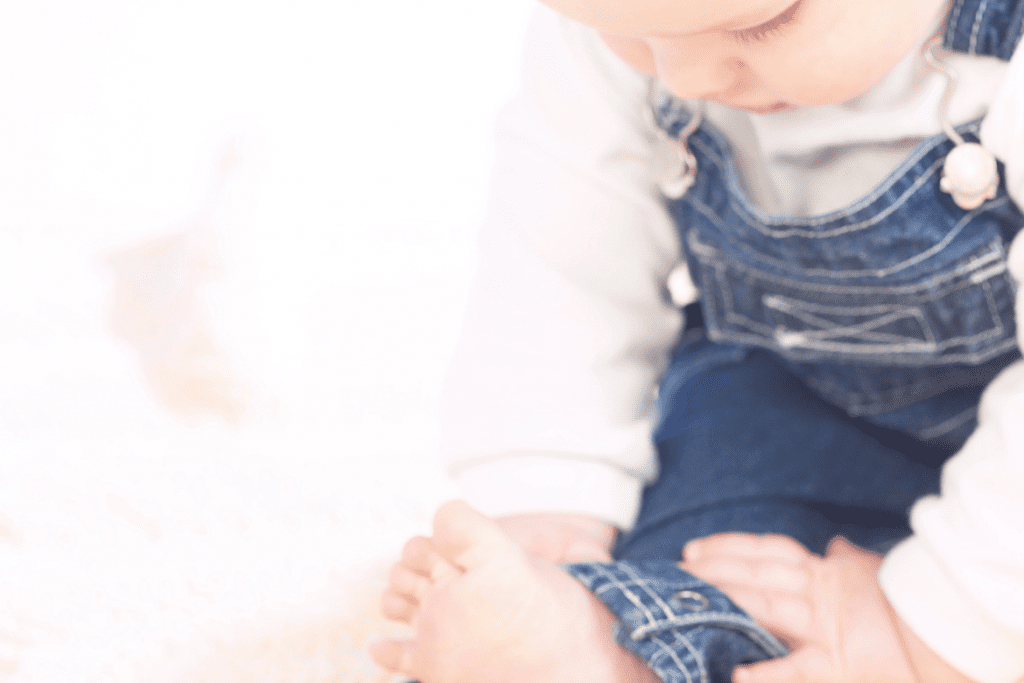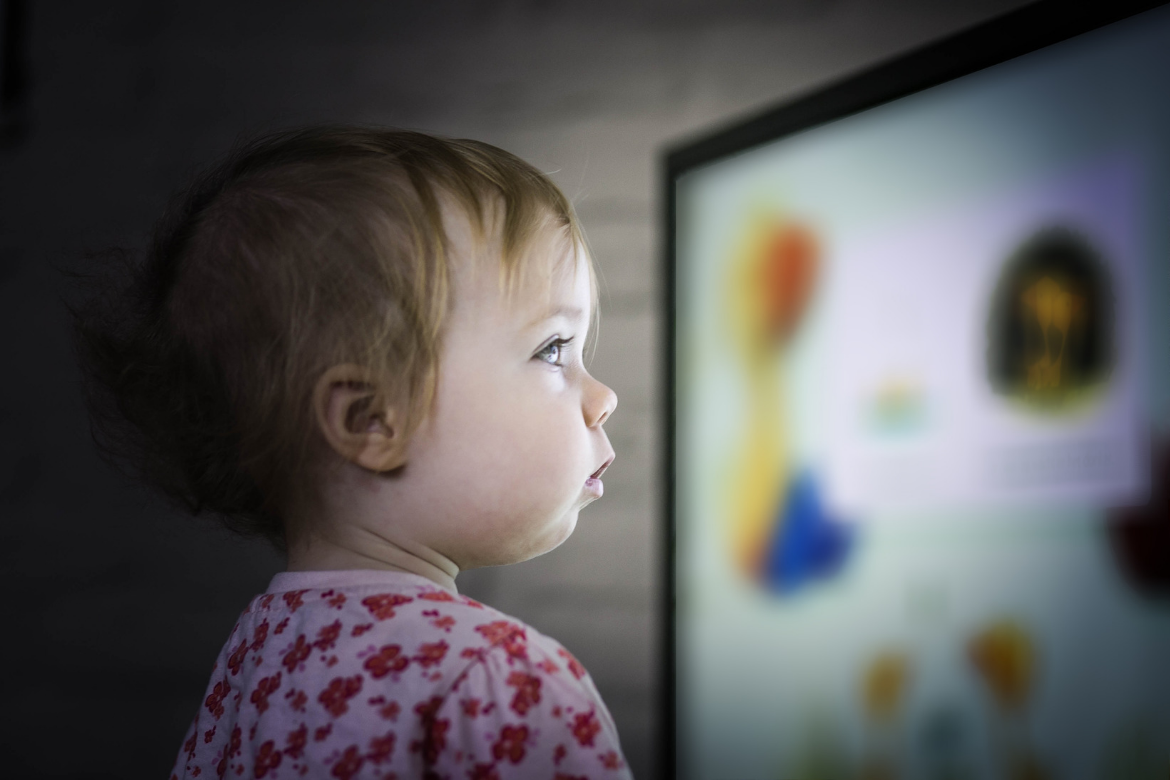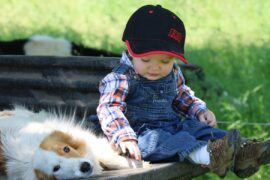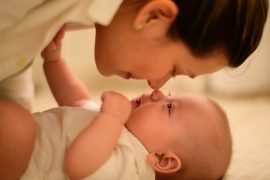
Another thing that can restrict a baby’s movement is clothing. Now, those gorgeous jeans may look cute, but they are not allowing your baby to bend at the knees, find their fingers or toes or feel their bodies. The same goes for the snug outfits that make your babies look like sumo wrestlers. It is essential to keep your baby’s hands and feet uncovered and limit the amount of time they are wearing restrictive clothing – keep it soft and flexible. Give them plenty of free time without clothing. When given the opportunity to just lie on their backs, they find their hands and feet, feel their legs and discover this is me.
Today, children in the developed world are spending less and less time outside and are known as the indoor generation. In the US, the average time children spend outdoors is between four to seven minutes a day (4). In the UK, prisoners spend more time outside than our children, and in Australia parents reported that 1 in 4 children under 16 years spend on average less than two hours of their spare time per week playing in natural outdoor environments (5). That is 17 minutes a day! We have become so disconnected from our natural environment that its importance seems to have been lost.
It is through touch that a baby perceives his or her boundaries through the skin and can truly experience the world around them.
However, nature provides innumerable sensory experiences that can’t be manufactured. It improves language skills and IQ, it enhances motor and sensory development, improves eyesight and promotes healthy sleep patterns. It also reduces the risk of ADHD and behavioural issues, boosts the immune system, builds resilience, creates more independent children, improves self-discipline as well as creates a sense of calm in both children and parents. Outdoor play inspires creativity and imagination. So allow your child to crawl, spin, pick up a stick or climb up on a rock. It is here that their greatest learning will take place. In contrast, a study conducted by Anna Sosa found that playing with electronic toys is associated with decreased quantity and quality of language input compared with play with books or traditional toys (6).
It is equally as important that you are a part of the process. It is your face that is their greatest stimulation. Babies learn expression of emotion through looking at your face – teaching them to smile, frown and look surprised. We are seeing more children who lack the ability to express emotion and who have delayed language development. One of the main contributing factors is our lack of interaction with our babies and children. We are often with them physically, but we are not connected. They are facing forward in their stroller whilst we have our headphones on listening to our favourite podcast, or our eyes are on our screen and not on our most precious gift. Our babies might be wired for learning but unless we provide the human stimulation they won’t learn.

And finally, your baby’s brain development can be further supported by touch. According to Bourke, touch is an essential part of building our babies’ brains and is critical for developing self-regulation (7). It is through touch that a baby perceives his or her boundaries through the skin and can truly experience the world around them. My favourite infant touch technique is developmental shiatsu. This provides deep pressure touch stimulating that release of serotonin and dopamine, two neurotransmitters that are responsible for creating a feeling of relaxation and calm.
Put down the phones and screens, pack away the bouncy chairs and the electronic toys and pick up your baby. Dance, sing, massage and play with your most precious gift. Limit the time your baby is in restrictive containers to no more than two hours per day. Your baby needs you more than ever and needs to be given the opportunity to move. move, move! Get outside and together you will discover magical things about each other that you didn’t know even existed.
To find out more on how you can support your baby reach their full potential, visit Barefoot Parenting.
REFERENCES
- Jack P. Shonkoff and Deborah A. Phillips, Editors; Committee on Integrating the Science of Early Childhood Development, Board on Children, Youth, and Families (2000) From Neurons to Neighborhoods: The Science of Early Childhood Development ISBN: 0-309-50488-0. Available. Online: http://www.nap.edu/catalog/9824.html
- Williams, J Dr. (2019) Why active babies make smart kids (Gymbaroo ) Online. Available: https://www.pbcexpo.com.au/baby/baby-development/why-active-babies-make-smart-kids/
- Audrey van der Meer (2017). “Babies exposed to stimulation get brain boost.” The Norwegian University of Science and Technology (NTNUScienceDaily. ScienceDaily)
- Children in nature. Improving Health by Reconnecting Youth with the Outdoors (2010). Online. Available: https://www.nrpa.org/uploadedFiles/nrpa.org/Advocacy/Children-in-Nature.pdf change to 4 from 9
- Missing Trees: The Inside Story of An Outdoor Nation. (n.d) Online. Available: https://treeday.planetark.org/documents/doc-1052-missing-trees—inside-story-of-an-outdoor-nation-report-2013.pdf
- Sosa, Anna. (2015). Association of the Type of Toy Used During Play With the Quantity and Quality of Parent-Infant Communication. JAMA pediatrics. 170. 1-6. 10.1001/jamapediatrics.2015.3753.
- Angela Burke , MA Ed, LMT (2014) Zen Shiatsu: A Longitudinal Case Study Measuring Stress Reduction in a Child with Autism Spectrum Disorder. International Journal of Therapeutic Massage & Bodywork: Research, Education, & Practice. Vol 7, No 4 http://www.ijtmb.org/index.php/ijtmb/rt/printerFriendly/246/315
- Silva, L., & Schalock, M. (2013). Treatment of tactile impairment in young children with autism: results with qigong massage. International journal of therapeutic massage & bodywork, 6(4), 12-20.
- Child in the city (2018). Children spend half the time playing outside in comparison to their parents Available. Online: https://www.childinthecity.org/2018/01/15/children-spend-half-the-time-playing-outside-in-comparison-to-their-parents/ (Sun 10th Jan 2019)
Follow back to basics footsteps to become empowered to be able to support and nurture your baby to their full potential. Using intuition, modern research and ancient wisdom, discover how you can give your baby the best start in life. Follow Dr Suzy McCleary’s work at the Barefoot Parenting website, on Facebook and Instagram.











I feel like parents keep babies wrapped tightly too much to .They wrap them so tightly in the wrap they can’t move their arms and legs but that’s just my thought .Its the swaddle they wrap them up in